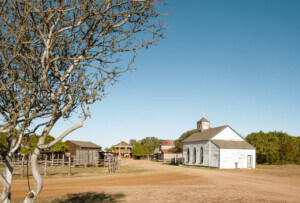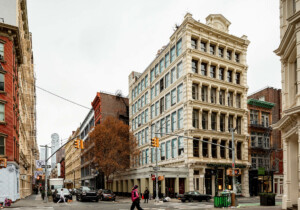Today the New York City Landmarks Preservation Commission (LPC) solicited input on the future of the city’s best-known—and most threatened—postmodern interior.
The commission heard testimony from its research department and members of the public on ONE UN New York Hotel’s (formerly the United Nations Hotel) Lobby and Ambassador Grill & Lounge, two glittery disco-era spaces designed by Kevin Roche and John Dinkeloo Associates.
As recently as January, the spaces inside the Midtown East building were set to be demolished by property owner Millennium Hotels and Resorts.
Local luminaries like Robert A.M. Stern, Belmont Freeman, and Alexandra Lange, as well as a bi-coastal Docomomo contingent spoke in favor of landmarking. The item would be the first postmodern interior to be designated a New York City landmark, and the “youngest” after Roche and Dinkeloo’s Ford Foundation (1963-68) which has interior and exterior landmark status.
The Ambassador Grill & Lounge, a small U-shaped restaurant in a windowless basement (1976), sports inset light fixtures, vaulted faux skylight clad in trellised mylar panels, and more shiny surfaces than Studio 54, all of which create the illusion of capaciousness and light. Along East 44th Street, the hotel lobby (1983) features a stepped glass dome roof accessed via a freestanding marble-columned hallway. The LPC’s research department called the connected rooms some of the “best public spaces” of New York from that period.
The researchers’ conclusions were reflected in public testimony that invoked the glamour of the rooms and their role in the see-and-be-seen public life of the city. Liz Waytkus, executive director of modern architecture preservation organization Docomomo, called Roche and Dinkeloo’s interiors “among the best” public spaces of the era. In contrast to the severity of modernism, the fluid spaces reflect a “humanistic” energy not often associated with the architecture of the time.
Docomomo’s Jessica Smith read a statement on behalf of Robert A.M. Stern. Stern offered “strong support” of designation, noting that Roche designed both the building itself and its interiors. He called the grill and lobby “masterworks of modernism produced by a master at his prime,” comparing them to surviving postmodern peers like Sir John Soane’s Museum in London and Adolf Loos’s American Bar in Vienna. Smith also read a statement for Curbed architecture critic Alexandra Lange, who said her research on postwar American corporate design suggests the rooms represent a “key moment” in late modern design. “The interiors change scale and increase the sensuality of a pair of large skyscrapers that draw the prismatic curtain walls of the UN buildings inside, creating a total work of architecture.”
To the frustration of many who testified, including Docomomo and the preservation advocacy organization Historic Districts Council (HDC), the commission did not include the lobby’s sunken seating area in the designation. The LPC said it believed the relative lack of original elements in the seating area merited exclusion, as the main lobby and hypostyle corridor under consideration offer a “processional experience” to and from the grill.
The iconic interiors have attracted attention beyond New York City. Daniel Paul, a Southern California–based architectural historian and expert in late modern glass skin architecture, flew in from L.A. to attend today’s meeting. Early this morning, he went to the hotel to check on the state of the interiors. Millennium, he said, has altered the space substantially but not irreversibly. In the grill, the faux skylight is covered in a semi-opaque “cheap-looking” plastic, while the neon acrylic wine racks were replaced by wood features. The bar’s tivoli lights are gone, and its mirrored backdrop has been replaced with wallpaper.
Despite the recent changes, Paul, a Docomomo member who with Waytkus drafted the RFE (a Request for Evaluation, the first step in the landmark process), said that Roche and Dinkeloo’s work is one of the most intact “high design” spaces of the era. “Taste goes in cycles,” he said. “When the cycle of appreciation takes a dip, that’s when these spaces are the most vulnerable.” Roche has offered to work with the property owners pro bono to see how the distinctive features could be preserved while updating the space to their satisfaction. (Update: In an email to Paul during the hearing today, Roche stated that his office would be willing to do an initial consultation pro bono but then “see where it goes.”)
Representatives from Millennium did not comment at today’s meeting.
As the discussion concluded, LPC chair Meenakshi Srinivasan stated that the commission would do further research and vote at to-be-determined meeting.










